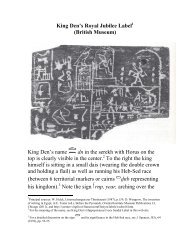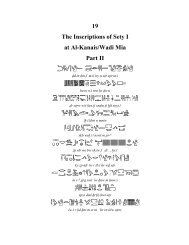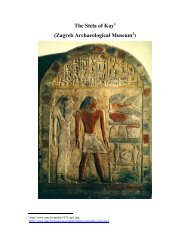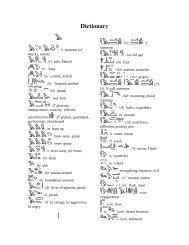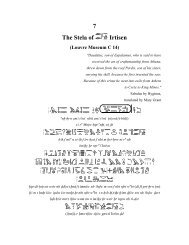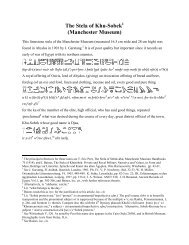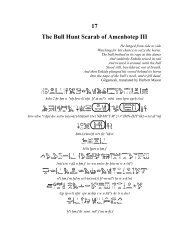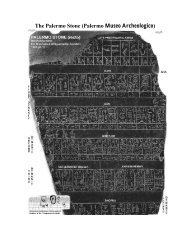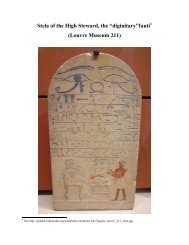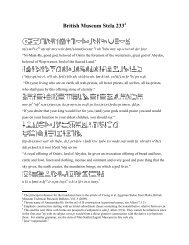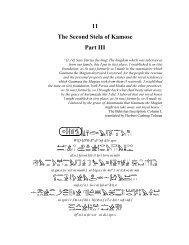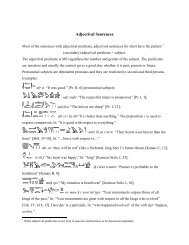Pronouns - Middle Egyptian Grammar
Pronouns - Middle Egyptian Grammar
Pronouns - Middle Egyptian Grammar
You also want an ePaper? Increase the reach of your titles
YUMPU automatically turns print PDFs into web optimized ePapers that Google loves.
<strong>Pronouns</strong><br />
Personal <strong>Pronouns</strong>: Suffix <strong>Pronouns</strong><br />
A suffix pronoun is attached to the very end of a word (nothing can come after it), and it is<br />
marked in transliteration with a dot. The various cases 1 are as follows:<br />
Gender and Number Transliteration Sign<br />
1S<br />
common gender<br />
2MS .k<br />
2FS .T or .t<br />
3MS .f<br />
3FS .s<br />
1PL .n<br />
2PL .Tn or .tn<br />
3PL .sn<br />
“one” (impersonal) .tw<br />
.i<br />
, , , , , , , , , etc. 2<br />
or suppressed<br />
,<br />
,<br />
,<br />
, , ,<br />
, , ,<br />
Suffix pronouns can be attached to different kind of words and have different grammatical<br />
functions:<br />
1. Possessor in a direct genitival construction following a noun A: A.f “his A,” lit. “A of<br />
his,” and also “A of him;” 3<br />
2. Object of a preposition: Hna.f “with him,” r.i “against me;”<br />
1<br />
Certain suffix pronouns are characteristic to some dynastic era. In some texts the scribe replaced by as a<br />
space saving device.<br />
2<br />
Depending on whom the suffix pronoun refers to.<br />
3<br />
For example, A=“fear, love, memory,” etc.<br />
, ,
3. Subject attached to a particle or introductory word: iw.f “He…,” r.f “so,”<br />
lit. “with respect to it,” aHa.n.i “Then I…,” wn.in.sn “Then<br />
they…” with the biliteral wn;<br />
4. Subject/object of an infinitive: sDm.f 4 “his hearing” or “hearing him;”<br />
5. Subject of various verb forms: sDm.f “he listens, “he will listen,” sDm.n.f “he listened,”<br />
etc.<br />
Examples for noun + possessor:<br />
zA.i “my son” 5 [Semna Stela 2, 18] with the biliteral zA “son,” where the first<br />
seated man is a determinative and the second is the suffix pronoun .i;<br />
Hm.i “my majesty” [Neferti 7] and in the next line of the same text Hm.f “his<br />
majesty;”<br />
snwi.k “your two brothers” 6 [Urk. IV, 618, 2], and a few lines later in the same text<br />
snti.k “your two sisters” 7 [Urk. IV, 618, 5];<br />
sxrw.f “his plans” [Kanais B, 13];<br />
snD.f “his fear” and also “the fear of him” [Khetty Stela 2, 7] with the triliteral snD;<br />
st.s “its place” [Neferti 68] (referring to Maat);<br />
mnat nt ib.f “nurse of his heart” [Khu-Sobek Stela 5, 2]. 8<br />
inwi.fi “his eyebrows” [ShS. 65], with the biliteral in, where the<br />
suffix pronoun after a dual has an extra i ending (occasionally found in duals).<br />
4 In <strong>Middle</strong> <strong>Egyptian</strong> the default verb is sDm “hear.”<br />
5<br />
Since the 1MS pronoun can be omitted, can also be read as zAwi(.i) “my two sons” or even as a<br />
dual zAwi “two sons.” The context almost always tells the correct meaning.<br />
6<br />
Horus and Seth.<br />
7<br />
Isis and Nephthis.<br />
8<br />
See T. Eric Peet, The Stela of Sebek-khu, Manchester Museum Handbooks 75 (1914).
Similarly, awi.ki “your two arms” 9<br />
awi.si “her arms;”<br />
Hr snnw.si “second time,” lit. “upon its second” [Urk. IV, 4, 9], where Hr is the<br />
preposition “on” and snnw is the cardinal number “second;”<br />
ity nb.n “sovereign, our lord” [Neferti 9] (apposition);<br />
zA.tn “(a) son of yours” [Neferti 6];<br />
Xwt.sn “their bellies” [Neferti 8].<br />
Examples for preposition + object:<br />
im.s 10 “in it” [ShS. 38, 120] (referring to a (feminine) boat);<br />
im.f “from it” [Neferti 20] (referring to originating from the land), and a few lines later<br />
the feminine Hr.s “from it” [Neferti 44];<br />
Hna.sn “with them” [ShS. 122];<br />
kA.k Hna.k “your ka (is) with you” [Nebankh Stela 4];<br />
n.sn “to them” [Neferti 5];<br />
Xr.i “for (lit. under) me” [Kanais B, 7] (spoken by Sety I) with the biliteral Xr.<br />
More complex examples:<br />
zA.i nDti.i “my son, my protector/avenger” (Amun Re speaks to Thuthmose<br />
III) [Urk. IV, 611, 17] (apposition) with the spindle biliteral nd often used with the nw-pot.<br />
ib.i m snw.i “my heart as my (only) companion” [ShS. 42], where<br />
snw stands for snnw, the ordinal number “second,” and the seated man determinative converts<br />
this to a noun “companion,” lit. “second one.”<br />
9 See G. A. Gaballa, JEA, 63 (1977), Plate XXIIA.<br />
10 The preposition alone cannot receive a suffix pronoun.
xtm ib.f snw n pHt ib.f “seal of his heart (and) equal 11 of his heart”<br />
[Khetty Stela 2, 6-7] (apposition of two direct genitives) with the ideogram xtm “seal.”<br />
sDm r.k n.i “So, listen to me!” [ShS. 12] with imperative of the verb sDm. The<br />
preposition r lit. “with respect to” with the attached 2MS suffix pronoun acts as the particle r.k<br />
and it can be translated by “so.”<br />
sDd.i r.f n.k “So, I will relate to you” [ShS. 21-22] with the verb sDd “relate,<br />
tell” in prospective/subjunctive sDm.f. 12<br />
iw.tw r irt aHAw “one makes arrows” [Neferti 40] with the<br />
impersonal suffix pronoun tw attached to the very common introductory particle iw. The verb<br />
form of iri “make” (spelled with the biliteral ir) is infinitive, lit. “one to make arrows.”<br />
ir.n.i “I have made” [Nebwaui Stela 1, 3] 13 and in line 10 of the same stela Dd.n.i<br />
“I have said.” The seated man is replaced by the reed leaf to save space; see footnote 1 above.<br />
anx.tw m Xr(i)-nTr 14 “one lives in the necropolis/cemetery” [Neferti 55].<br />
The noun Ds “self” with an attached suffix pronoun is used as a reflexive pronoun:<br />
Ds.tn “you yourselves”[Kanais B, 13];<br />
awi.i ds.i my own (two) arms [Urk. IV, 612, 13];<br />
Hrw Ds.f Horus himself [Itrysen Stella 6];<br />
Dd Ds.tn “Speak your own (words)!” [Kanais B 13]. Dd “speak” is imperative and the<br />
plural strokes indicate that the exclamation is addressed to several persons (actually gods). There<br />
occurs here an interesting use of Ds.tn with literal meaning: you yourselves. Since the pharaoh<br />
asks the gods to speak, it means: your own (words).<br />
11 Lit. “second end.”<br />
12 One of the six sDm.f verb forms. In Standard Theory it is called prospective sDm.f and in Allen’s terminology it is<br />
the subjunctive sDm.f.<br />
13 See E. Frood, JEA, 89 (2003) pp. 59-81.<br />
14 For the nisbe construction Xri-nTr, see Adjectives.
Personal <strong>Pronouns</strong>: Dependent (Enclitic) <strong>Pronouns</strong><br />
The dependent pronouns can stand by themselves as separate words but they depend on a word<br />
that they follow. (Consequently, they are never the first word of a sentence.) The various cases<br />
are as follows:<br />
Gender and Number Transliteration Sign<br />
1S<br />
common gender<br />
wi<br />
2MS Tw or tw<br />
2FS Tn or tn<br />
3MS sw<br />
3FS si<br />
1PL n<br />
2PL Tn or tn<br />
3PL sn<br />
1N st<br />
“one” (impersonal) Tw<br />
The dependent pronouns have different grammatical functions:<br />
1. Second and third person subjects of adjectival sentences; 15<br />
, , , , , etc.<br />
i often suppressed<br />
, ,<br />
, , ,<br />
,<br />
, , ,<br />
, , ,<br />
2. In adjectival sentences of possession ni AB 16 with A a dependent pronoun:<br />
“A belongs to B;”<br />
3. Subjects of adverbial sentences (after certain introductory particles such as m.k, nn, isT<br />
etc.);<br />
4. Subject of imperatives (if expressed);<br />
15 See Adjectival Sentences.<br />
16 See Adjectival Sentences.<br />
, ,
5. Objects of various transitive verb forms.<br />
Examples for adjectival predicate + subject:<br />
nfr st “it was good.” [Pr. II, 6];<br />
dSr sn “they will be red” (like a firebrand, a pharaoh’s threat) [Kanais C, 12].<br />
Examples for imperative + subject:<br />
mr wi “love/take pity on me!” [Neferti 45];<br />
ia tw “Wash yourself!” [ShS. 13];<br />
in n.i sw “Bring him to me!” [Neferti 11] with the bilateral in, and the dative n.i “to<br />
me” in forward position;<br />
zAw tn “you beware” [Kanais C, 4].<br />
Examples for verb + object:<br />
sDm.f .<br />
Hzy.tn wi “you will bless me” [Kanais B, 11] with prospective /subjunctive<br />
Hs.n wi (the pharaoh) “favored me” [Nebwaui Stela 1, 11], and in line 16 the same phrase is<br />
written as Hs.n w(i). Clearly the scribe was trying to save space.<br />
Example with introductory particle:<br />
More complex examples:<br />
m.k tw “Look, you…” [ShS. 117].<br />
mnwi tw m st.k nt nHH “How firm are you in the seat of<br />
eternity!” [Nebankh Stela 3] with the biliteral st and exclamatory adjectival predicate mnwi;<br />
aHa.n rdi.f wi m r.f “then he put me into his mouth” [ShS. 76-77].<br />
Personal <strong>Pronouns</strong>: Independent (Stressed) <strong>Pronouns</strong><br />
Independent pronouns are separate and independent words and almost always stand at the head<br />
of a sentence. The various cases are as follows:
Gender and Number Transliteration Sign<br />
1S<br />
common gender<br />
ink<br />
2MS ntk<br />
2FS ntT or ntt<br />
3MS ntf<br />
3FS nts<br />
1PL inn<br />
2PL ntTn or nttn<br />
3PL ntsn<br />
, , , ,<br />
, , , etc.<br />
The independent pronouns have different grammatical functions:<br />
1. In AB nominal sentences: First- or second-person independent pronoun in part A as<br />
subject or predicate, and third-person independent pronoun in part A as predicate. 17<br />
2. In A pw nominal sentences: Independent pronoun in part A is always the predicate.<br />
3. In A pw B nominal sentences: Independent pronoun in part A is always the predicate<br />
(rare).<br />
4. First person (singular and plural) subjects of adjectival sentences; 18<br />
5. Part A in adjectival sentences of possession ni AB: “B belongs to A;”<br />
6. Agent of an infinitive (rare).<br />
Examples:<br />
ink xtmt(i)-nTr “I am a royal seal bearer/treasurer” [Khetty Stela 2, 2];<br />
ntf zA wsir “He is the son of Osiris” [CT IV 37 f Sq6C] 19<br />
17 Here and below; for details see Nominal Sentences.<br />
18 Here and below; for details see Adjectival Sentences.<br />
19 CT is reference for the 7-volume work of A. de Buck, The <strong>Egyptian</strong> Coffin Texts, Oriental Institute, Chicago.<br />
,<br />
,<br />
,<br />
,<br />
,
nts ra “She is Re” [CT VI 166c B4C];<br />
nttn nA nbw “You are the lords” [Kanais B, 13];<br />
ntsn nbw pt “They are the lords of the sky;”<br />
n(i)-ntk nbw “Gold is yours” [Urk. IV, 96].<br />
A more complex example:<br />
ntf swAH irrt.i “He is someone who makes/shall make my deeds endure”<br />
[Kanais C, 8] (swAH “set, make endure” is a causative verb, here a participle “who makes<br />
endure.” irrt.i lit. “(those) that I have been making” is a feminine (imperfective) relative form<br />
and as such it often has future meaning. The plural is indicated by strokes and the suffixed<br />
subject is visibly a king, actually Sety I).<br />
Demonstrative <strong>Pronouns</strong><br />
One of the forerunners of the <strong>Middle</strong> <strong>Egyptian</strong> demonstrative pronouns were adjectives<br />
with deictic 20 functions. They are formed by the pronominal bases MS p-, FS t-, MPL ip-, FPL<br />
ipt-, and the deictic indicators –n (nearby), -f (distant), -w (< i, nearby), and –A (vocative and/or<br />
colloquial). Combining these yields the early <strong>Egyptian</strong> n-series pn, tn, ipn, iptn, the f-series, the<br />
w-series, and the A-series (in the latter the plurals are not attested). In addition to these, another<br />
set of neutral demonstrative pronouns was formed by the pronominal base n- and the deictic<br />
indicators: nn, nf, nw, nA. In <strong>Middle</strong> <strong>Egyptian</strong>, the n-series replaced the w-series pw (< pi), tw (<<br />
ti), ipw, iptw (the latter found mostly in older religious texts) and the pronoun pw acquired the<br />
function as copula 21 “this [is]” > “is” in nominal sentences. In addition, the earlier plurals (in<br />
both genders) have been replaced by a construction using the neutral n-demonstrative pronouns<br />
followed by the genitival adjective n.<br />
The most frequently used <strong>Middle</strong> <strong>Egyptian</strong> demonstratives are summarized in the following table:<br />
20 Specifying location or identity from the perspective of the speaker.<br />
21 Linking verb; see Nominal Sentences.
MS FS N<br />
transliteration sign transliteration sign transliteration sign<br />
pn<br />
pf, pfA 22<br />
pA<br />
,<br />
, ,<br />
tn<br />
tf, tfA<br />
tA<br />
,<br />
nn<br />
nf, nfA<br />
The n-series and the f-series are usually used together for contrast: “this” and “that.” In later<br />
<strong>Egyptian</strong> the A-series evolved into the definite article. When the demonstrative pronouns are used<br />
by themselves (without an accompanying noun), <strong>Middle</strong> <strong>Egyptian</strong> usually uses the neutral forms.<br />
The relative position of MS/FS demonstrative pronouns to a noun A are as follows:<br />
A pn/tn, pA/tA A, pf/pfA/tf/tfA A or A pf/pfA/tf/tfA<br />
The plurals always precede the noun:<br />
Examples for n-series:<br />
ra pn “today,” lit. “this day” [Neferti 4];<br />
nn n A, nfA n A, nA n A<br />
tAS pn “this border” [Semna Stela 2, 17-18];<br />
iw pn n kA “this island of ka” (or phantom island 23 ) [ShS. 114], with pn in forward<br />
position within the indirect genitive; similarly:<br />
abA pn n Dt “this offering stone of eternity” 24 with the bA-bird ;<br />
dmi pn “this town” [Urk. IV, 4, 3] and a bit later in the same text:<br />
pA dmi [Urk. IV, 4, 6];<br />
Hwt-nTr tn “this temple” [Kanais B, 10] with honorific transposition in A;<br />
st tn “this place” [Urk. IV, 3, 16];<br />
22 The members of the f-series occasionally show an extra A-ending (always in plural).<br />
23 Maspero’s translation.<br />
24 British Museum Stela 233, line 2; see this web site.<br />
nA<br />
,<br />
,
Ostracon) with the biliteral wa;<br />
wa m nn n hrw one of these days [Neferti 2] (emended from Liverpool<br />
Dd.n.i nn n “I speak as follows,” lit. “as these” [Kanais C, 2].<br />
Examples for f-series:<br />
Dw pf n pr-Hrw-n-xtiw-mfkAt “that mountain of the<br />
House-of-Horus-of-the-Turquoise-Terraces” [Khetty Stela 2, 4] with xtiw “terraces”<br />
( is a determinative);<br />
nfA n bw-nfr “those good things” [Neferti 30] with bw-nfr, an<br />
<strong>Egyptian</strong> idiom for good things;<br />
Examples for A-series:<br />
nfA n DfAw “these provisions” [Neferti 32].<br />
pA mAw pA bik “the sight of the falcon” [Kanais A] (referring to<br />
the swiftness of the falcon’s eye), where pA is originally a demonstrative pronoun but here<br />
it is used as the definite article “the;”<br />
24];<br />
tA Tzt pA nbw “the transport (lit. journey) of the gold” [Kanais A];<br />
nA n dmiw n tA kmt “those towns of Egypt” [Kamose Stela 2,<br />
nA (n) nbw “the lords” [Kanais B, 13] (the genitival adjective is suppressed as the<br />
following noun starts with n).



